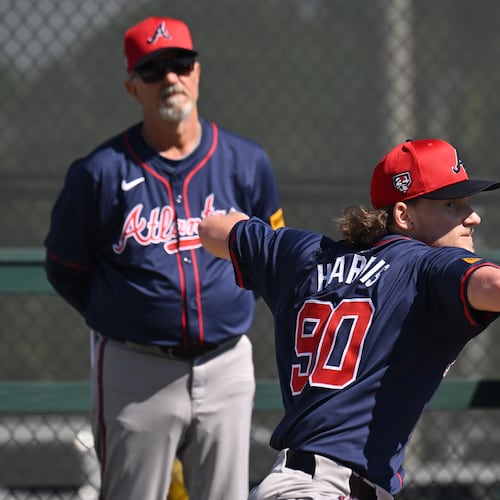On Sunday on a national TV broadcast from Atlanta, Philadelphia base-runner Alec Bohm slid in the general vicinity of home in the ninth inning with what proved to be the deciding run of a 7-6 Braves loss.
Bohm still hasn’t touched the plate.
To all the millions of unpaid volunteer review officials on their couches at home and the thousands in their seats at Truist Park, multiple replays seemed to show Bohm missing the plate. Meaning the run shouldn’t have counted. Meaning the score was still tied.
Yet after a nearly three-minute review back at Major League Baseball’s replay center in New York, a far more authoritative source neither confirmed nor overturned the call. Rather it let the call stand, shorthand for that gray third category in which the far-away replay official cites insufficient evidence to overrule the game umpire’s call.
Days later, in conversation with the AJC about replay review and that call in particular, the man in charge of the system still could not definitively say the judgment was mistaken.
Said MLB’s Senior Vice President for On-Field Operations Michael Hill: “At the time the decision was made, our replay center went through our normal processes and angles and couldn’t overturn it. Since, in going back through everything, there was a view that did come late in the process – actually came after the decision was made – that could have been useful in evaluation of the play. Could it have overturned it? I can’t say that definitively, but it’s one that could have been helpful to our process. That’s why we constantly review everything that goes in there.”
Translation: OK, maybe there exists video of Bohm clearly missing home that MLB would consider conclusive. Apparently all else is of Zapruder film quality. But MLB didn’t see it in time.
Extrapolation: If you ever thought replay review would turn the murky waters of officiating a clear, crystalline blue, please run that idea to further review.
Two recent plays have forced baseball and its acolytes to review the review.
Before the play in Atlanta there was the case of Michael Conforto and the Furtive Elbow. On April 8, the Mets’ Conforto appeared to sneak his heavily armored hinge into the path of a Florida Marlins pitch. Bases loaded in the ninth, it was a walk-off hit-by-pitch. Because of the limitations on replay review, the official could rule only on whether the pitch struck Conforto. Not on whether he intentionally stuck out his elbow (he had) or whether the pitch was a strike (it was). Either ruling would have reversed the call, and no winning run would have scored. But the existing rules of replay review didn’t allow for that.
If you want to hear the range of opinion on baseball’s replay review system, introduced in very limited form in 2008 and evolving ever since, listen to the broadcaster and the executive.
Joe Simpson has called Braves games since 1992 and as such has of late served as middleman between the replay reviews and the fans. The replay relay man, if you will.
“At first, I was a huge proponent of it,” Simpson said. “I thought it was great because they’d be able to get calls right. And the more we’ve gone along here I realize that they still miss them.”
The executive in charge is predictably more bullish on the system. “You can see how progressively better replay has gotten and how progressively faster replay has gotten,” Hill said. “It’s great for our game. It’s made our game better. With our fans and staff on field, the expectation is that when we have the angle, we get it right. And when that happens, we can overturn the call if we have to. But when we don’t have that information, that’s when the call stands and it goes with what is called on the field.”
Since 2014, according to MLB, there have been 4,237 on-field calls overturned by replay. To Hill’s view of the bigger picture, that 4,237 little wrongs that have been righted. That’s worth the occasional pop-up controversies, he’ll insist.
Over that time, roughly 48% of the on-field calls were overturned, 22% confirmed, 30% let stand, as in the Braves case.
To aggrieved parties, the system can seem 100% flawed. As Drew Smyly, the Braves starter that Sunday night said, “For MLB not to overturn (the Bohm run), it’s embarrassing. Why even have replay if you won’t overturn that?”
In the wake of a couple of shaky calls, a few popular suggestions for improving replay review have resurfaced. Chief among them is one most lately forwarded by Braves shortstop Dansby Swanson: Keep the review officials in the dark about the original call. Let them make their call independently, just as they see it, thereby eliminating the bail-out of letting the on-field umpire’s call simply stand. Also, it eliminates any impression of the review official just standing up for his on-field brethren.
Hill is not taken with that suggestion. “They (the on-field umpires) are in the moment, they’re live, they’re there, and I think replay is there to add another layer to what they do in order to ensure the call gets right,” he said. “If you take out what they’re doing on the field as it pertains to those calls, I’m not sure the mechanics of replay can continue to be as effective. ... You eliminate the eyes closest to the play.”
Simpson, quite familiar with Hill’s work as a former Miami Marlins president of baseball operations, counters: “I think Michael Hill is a really good baseball man, but I disagree with him on this. There are calls now that overturn the eyes that are on it locally. What’s wrong with having an additional set of eyes make that decision?”
An unapologetic old-school baseball guy, Simpson is for contracting review rather than expanding it further. But expansion seems to be the natural, evolutionary trend. That would be the only remedy to the Conforto situation, adding other layers of game situations open to review.
“That’s something that’s constantly under review,” Hill said. “We’re all caretakers of the game. We want to do what’s right for the game. If there are areas that need to be re-evaluated in terms of what’s reviewable and what’s not, that’s something on an annual basis we can entertain.”
Given all the technology at baseball’s command, we just assume that the imperfect human element has been gradually removed from officiating. Not so, as the last few days have demonstrated. “Maybe that’s our fault as the consumer. We expect perfection, and if we don’t get it, we’re upset about it,” Hill said. “Just know that’s our goal, that’s what we’re striving for. The goal is to get the call right, and that has never changed.”
“The goal is to get calls rights,” Hill said. “We average more than 1,300 reviews a year, and we talk about a handful of calls on a season that are controversial. Obviously, Drew Smyly and the fans were thinking about that one play because it was a pivotal part of the game. But I’ve been watching the (recently concluded Braves-Marlins) series and there were calls that went the Braves way. That’s when you don’t hear from Drew Smyly; you don’t hear from Braves fans. You just hear people cheer because the call went for the Braves. I get it. That’s just natural.”
Still those like Simpson have been left to wonder, “When they can’t get that one right on the slide at home or Michael Conforto sticking his elbow in front of a pitch, then I go with the other players and ask what good is it? Why have it if you can’t see something that obvious?”
Meanwhile, Alec Bohm still has not touched home plate.
About the Author
Keep Reading
The Latest
Featured


